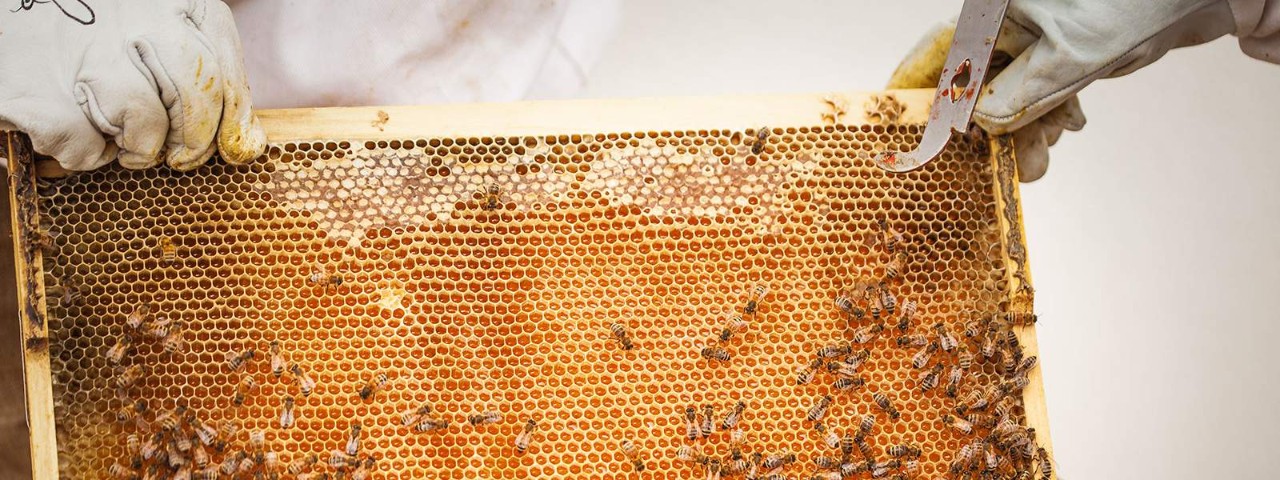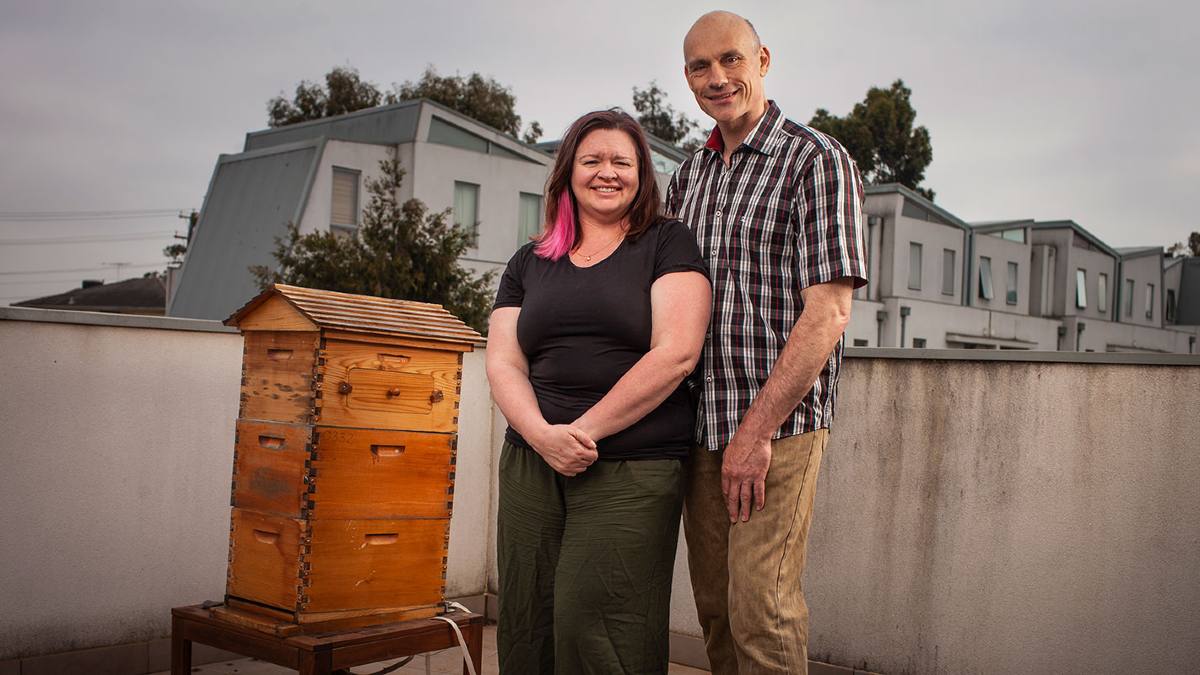Boxing Day is the perfect time to secure your next getaway, with savings on RACV Resort stays.
Plan bee: Rise of the backyard beekeeper

With bee colonies under threat, backyard beekeepers are swarming to the rescue.
Nicole and Phil Owen keep 60,000 pets on their suburban balcony, but their neighbours remain for the most part blithely unaware. “Generally, the only time they realise we have bees is when we get out there with our full protective suits on,” says Nicole.
Living in Melbourne’s Doncaster, which is a long way from rural cliche, Nicole and Phil are part of a growing urban beekeeping movement.
Seven years ago there were 1630 registered beekeepers in Victoria. Now there are 9155, most of whom are hobbyists with only one to five hives.
Beekeeping clubs are reporting a surge in memberships, and people are making a beeline for beginners’ courses. With concerns about declining bee populations a big-picture factor, this buzzing zeitgeist has even entered the realm of reality TV. Screened last year on the ABC, the Great Australian Bee Challenge followed four groups of novices learning the sticky art of apiary – with the aim of getting their honey on the menu of the flash Sydney restaurant Bennelong.
The beekeeping demographic also appears to be changing, from male-dominated to a fairly even balance. “There are certainly a lot more women now interested in beekeeping,” says Alan Redpath, from Redpath’s Beekeeping Supplies in bayside Parkdale. He says that change has coincided with the advent of pre-made hives. “You don’t have to bash them together yourself any more.”

Victorian backyards have become a hive of activity for hobby beekeepers like Nicole and Phil Owen
Like many newcomers to the fascinating world of hives and homemade honey, Nicole and Phil began with a budding awareness of the crucial role the industrious insects play in garden ecosystems.
“We have citrus trees and wanted to do something to help their pollination, and bees are the best thing,” says Nicole.
Their first step was to confirm whether their townhouse balcony was a good place for a hive (it was, especially as it keeps the bees’ flight path above the neighbours). They then took a course to familiarise themselves with the tools of the trade and get a primer in bee – and human – psychology 101.
“One of the most useful things in the course was being introduced to the bees for the first time,” says Nicole. “Even though they were wearing full protective suits some people realised they couldn’t handle the bees flying around them and that they shouldn’t go ahead with getting a hive.”
Last season Nicole and Phil’s balcony hive produced a staggering 32 kilograms of liquid gold, much of which they gave to family, friends and neighbours. “It’s good to keep the neighbours sweet,” says Nicole.
“It really has been amazing to have honey we produced on our property from local flowers. Maybe I’m biased but it’s like when you grow vegies for yourself – they really do taste so much better.”
With bee populations under threat worldwide from pesticides, industrial agriculture and climate change, beekeepers are the living embodiment of the environmental adage “Think global, act local”.
Along with cities such as Paris, London, San Francisco, New York and Hong Kong, Melbourne is a thriving centre of urban beekeeping. Local beekeeping luminaries Vanessa Kwiatkowski and Mat Lumalasi established Rooftop Honey in 2010 with a vision of boosting the bee population in and around the city. They place hives on the roof spaces of cafes, restaurants, shopping centres and hotels.

Backyard beekeeping can be a greta sustainable practice, just make sure you're careful
Anada in Fitzroy and Park Street Dining in Carlton North are two such buzzing eateries, while the Emporium in the CBD has 13 rooftop hives. Hotels with hives include the Pullman in Albert Park and the Sebel in Flinders Lane. Vanessa and Mat also look after 40 hives at various retirement and aged-care facilities, where residents can join in hive inspections.
“Our aim was really to be part of this global effort to help save the honey bee from the threats of disease and human habitation,” says Vanessa. “And keeping bees will increase the yield of your vegie patch by between 30 and 50 per cent. So what’s not to love?”
A bee sting, perhaps? “I get stung maybe a few times a season, but it’s usually my fault,” says Vanessa. “If I pick up a frame and it still has a bee on it, for example. A low-pressure front on the way can make them more aggressive, too. If I open a hive and it’s not happy, I close the hive.”
For Nicole and Phil Owen, keeping bees has been a constant process of discovery. “Every time we open the hive we learn something new about how the bees act,” says Nicole.
“We love getting up in the morning and going out to have a look at what they’re up to. Ask any beekeeper about bees and they won’t stop talking. Once you start you get a bit obsessed.”
Bee aware
The world needs bees. Three out of four food crops and 90 per cent of wild plants depend to some extent on bee pollination. With climate change, habitat loss, intensive farming methods and pesticides that expose bees to the deadly varroa mite, colony numbers have fallen by an estimated 40 per cent in the United States since 2006, and 45 per cent in Britain since 2010, according to Greenpeace. While strict quarantine rules have kept Australia varroa-free, the global decline has the World Health Organisation and the United Nations on alert. The first annual World Bee Day was held in 2017, with the UN’s Food and Agriculture Organisation urging countries and individuals to help protect bees, or suffer a drastic drop in food diversity.

Homemade honey apple torte
Honey apple torte
Ingredients
Base
- 1 packet Marie biscuits
- 125 grams unsalted butter, melted
- 1 tablespoon cinnamon
- ¼ cup sugar
Filling
- ½ cup honey
- 1 cup cream
- 3 eggs
- 400 grams apples (fresh or tinned) – if fresh, stew beforehand with honey
Method
- For the base: whizz biscuits and combine with remaining base ingredients. Press two thirds of mix into pie dish. Set aside one third for top.
- Mix eggs and cream.
- Combine with apple and honey.
- Pour over base and top with remaining biscuit mix.
- Bake for 40 minutes at 170 degrees.
How to have your own hive
- Get a permit. Every hive in the state has to be registered with Agriculture Victoria. It’s free to register up to five hives online at agriculture.vic.gov.au.
- Get equipped. Beekeeping suppliers can sell you a small nucleus hive consisting of four or five frames along with a queen bee and a few thousand little helpers. A smoker is also necessary to subdue the bees when the hive is opened. Protective clothing is another essential. Choose white coveralls (bees prefer light colours) with elasticised cuffs at the wrists and ankles. Add a protective hat and wire veil, gloves and sturdy boots and you’re in business.
- Get connected. The richest source of advice is other beekeepers. Join your local beekeeping association and tap into a wealth of support and information.


